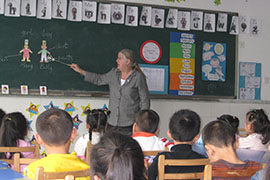EDS: An earlier version of this story misstated the scope of this fall’s teacher shortage. The errors occurred throughout the story and in the graphic. Clients who used previous versions are asked to replace them with the text and graphic below, which have been corrected, and to run the correction found here.
- Slug: BC-CNS-Teacher Shortage WRITETHRU,640 words.
- Photo, graphic available (embed code, thumbnail, caption below).
By Adrienne Washington
Cronkite News
WASHINGTON – Nearly one-third of teacher vacancies in Arizona public and charter schools were still unfilled one month into the school year, according to a new report, the most in eight years of data on school vacancies.
The Arizona School Personnel Administrators Association report for the 2023-24 school year said that of the 7,518.3 open teacher positions this fall, 2,229.7 were still unfilled as of September, or 29.7% of the openings. That is up from 26.9% at the same time last year.
The report also said that of the 5,288.6 teachers hired, 3,997.4 of the slots were filled by teachers who do not meet the state’s standard certification requirements, but are allowed to teach under an alternative pathway. That translates to 75.6% of the new hires.
The survey is based on responses from 131 school districts or charter schools that had a total of 45,221.2 teaching positions budgeted for the 2023-24 school year.
Advocates pointed to the report as further proof of the state’s failure to adequately fund schools.
“This crisis will continue to deepen until we invest in our schools,” said Arizona Education Association President Marisol Garcia in a written statement.
A report by the National Education Association showed that the average Arizona teacher made $56,775 in fiscal 2021, the 32nd-lowest salary in the country at the time. The state fares even worse in per-pupil spending: A Census Bureau report said the $10,330 that Arizona spent in fiscal 2022 trailed every state for which there was data, except Idaho.
Save Our Schools Director Beth Lewis, a teacher herself, said she has seen “firsthand the horrific lack of resources, low teacher pay and just the way that that was impacting kids specifically in low-income communities.”
“Teacher vacancies negatively impact student learning in every possible way,” Lewis said in a text message. “These vacancies also snowball, leading to worse teacher retention when educators don’t have the supports they would receive in a fully-staffed school.”
Lewis said that snowball effect forces teachers to leave the classroom, leaves parents dissatisfied and students without the support they need.
Justin Wing, the data analyst for the ASPAA, said the number of unfilled vacancies a month into the school year has usually hovered around 25%, but this year’s numbers are a new high.
“We have not as a nation identified the significant root causes for the teacher shortage and we have not addressed those,” Wing said.
Wing said it’s important to note not only the vacancies but also the number of teachers who are hired by alternative pathways and do not have to meet standard teacher requirements.
“I don’t know where we would be if the state of Arizona did not provide alternative pathway opportunities,” he said.
Garcia said the problems of low teacher pay and low per-pupil spending are not being helped by the state’s new universal Empowerment Scholarship Account program, which gives a cash stipend to parents who enroll their children in a private school. That program had enrolled more than 60,000 students as of June and could reach as many as 100,000 students by next summer, a level that would create a $320 million budget deficit, critics say.
“The extremist majority in our Legislature has insisted on diverting money away from schools and students and towards vouchers, tax cuts for the wealthy and other programs that benefit the rich and well-connected,” Garcia said in her statement. “As a result, we spend less per student than almost any other state in the nation, and our schools struggle to retain experienced, passionate staff.”
That sentiment was echoed by Lewis, who has taught in Arizona for 12 years.
“Low educator pay and poor working conditions are driven by Arizona’s persistent refusal to fund our public schools, leaving our students chronically behind,” she said. “Our state leaders are failing our teachers and our kids.”
For more stories from Cronkite News, visit cronkitenews.azpbs.org.
^__=
Web links:
_ ASPAA report: https://cdn.ymaws.com/www.aspaa.org/resource/resmgr/documents/press_releases/ASPAA_Press_Release_-_Septem.pdf
_ NEA report: https://www.nea.org/resource-library/educator-pay-and-student-spending-how-does-your-state-rank
_ Census report: https://www.census.gov/library/visualizations/interactive/how-did-covid-19-affect-school-finances.html
_ Graphic embed code: <div class=”flourish-embed flourish-chart” data-src=”visualisation/15230597″><script src=”https://public.flourish.studio/resources/embed.js”></script></div>
^__=
Arizona schools started another school year with large numbers of vacant teaching positions, and even more jobs filled by teachers who are not fully certified, a new report says. Advocates blame the shortages on the relatively low pay for teachers in the state. Here, a Peace Corps volunteer teaches an English class in a 2011 photo. (Photo courtesy Peace Corps)
